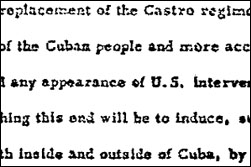
Eisenhower ordered
the CIA to plot
Castro's overthrow.
 | In the winter of 1960, Eisenhower ordered the CIA to plot Castro's overthrow. |
When rebel forces under the command of Fidel Castro completed the overthrow of Cuban dictator Fulgencio Batista on New Year's Day, 1959, the future of U.S.-Cuban relations became uncertain, at best. As the year progressed, Castro solidified control over the revolutionary government and initiated an ambitious program of reforms, replacing American companies' control of key industries with economic measures focused on national development. The new policies threatened the profits and land holdings of U.S. businesses, causing the administration of Dwight Eisenhower to increasingly turn a hostile glance at Cuba.
By the winter of 1960, just a year after the Revolution, President Eisenhower and his key foreign policy advisers were convinced that Castro's government needed to be replaced-soon and by any means necessary. On March 17, 1960, Eisenhower authorized a Central Intelligence Agency plan, titled A Program of Covert Action Against the Castro Regime. The document states that the program's objective is to "bring about the replacement of the Castro regime with one more devoted to the interests of the Cuban people and more acceptable to the U.S. in such a manner as to avoid the appearance of U.S. intervention."
The CIA set about the task zealously, eager to attempt a rerun of their successful 1954 operation to overthrow Guatemala's leftist leader, President Jacobo Arbenz. Much of the Agency's planning for the Cuba program was modeled on the Guatemala campaign, which was conducted to appear as an independent invasion of the country by forces under the command of an exiled military officer, Carlos Castillo Armas. In addition to training, funding and directing the small invasion force, the CIA launched a large radio propaganda effort and arranged for some small-scale, but frightening, aerial bombings in Guatemala City. Arbenz was spooked out of office, and the CIA, with assistance from the U.S. ambassador to Guatemala, installed Armas as the new president.
Convinced that this combination of armed intervention, sabotage and psychological warfare could also spur Castro's overthrow, the CIA began training a force of Cuban exiles who would ultimately man the U.S.-sponsored invasion of Cuba, and quickly established anti-Castro radio broadcasting. Though the CIA subsidized many stations in the Caribbean, the major conduit for the Agency's propaganda was Radio Swan, a station beaming its signal from Swan Island, a tiny spot of land off the coast of Honduras.